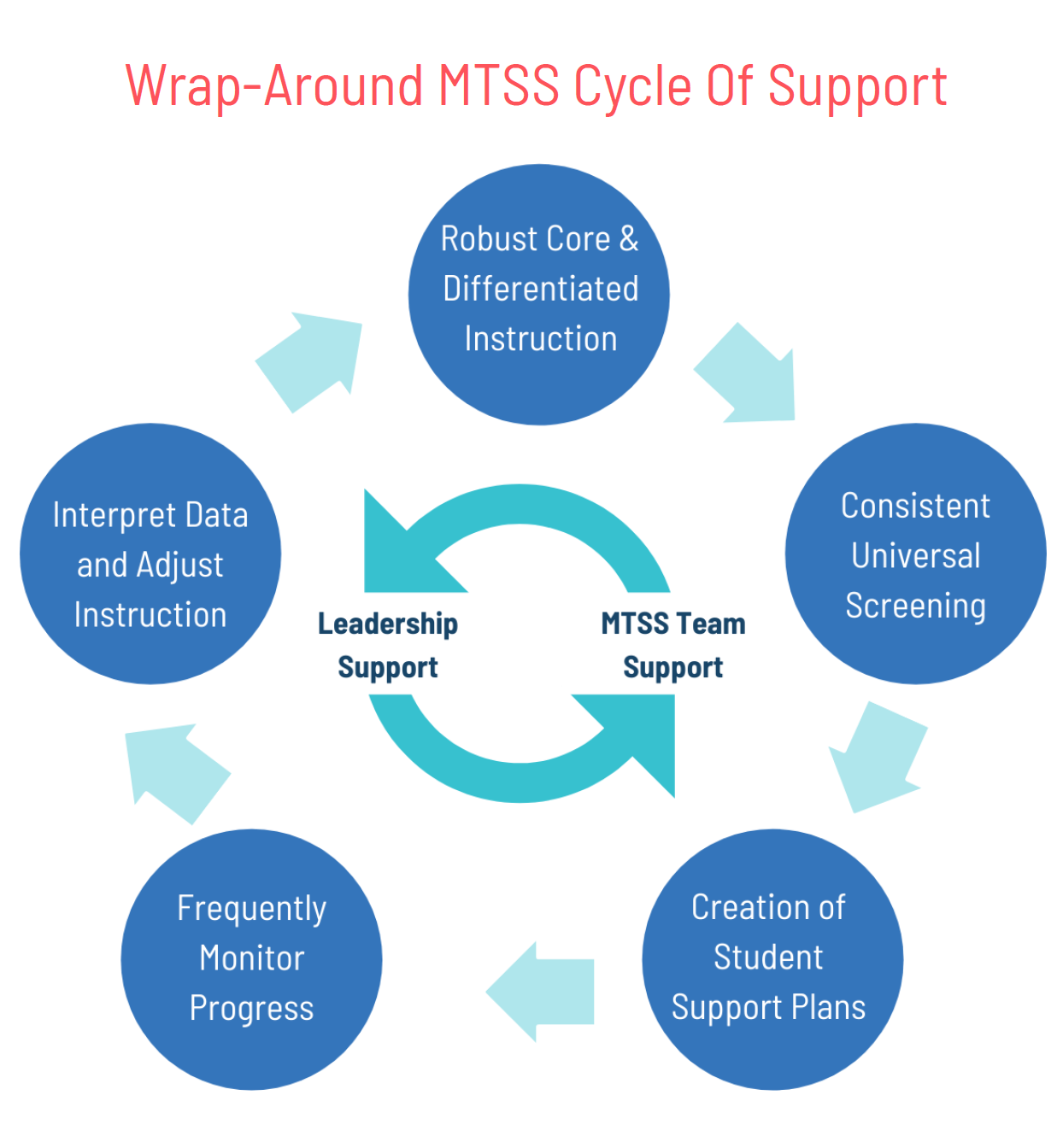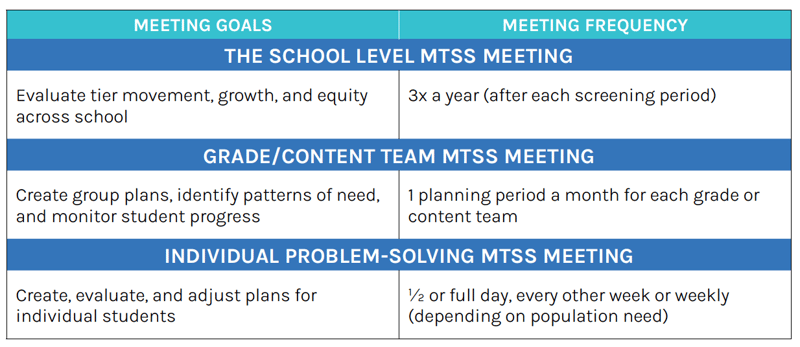Welcome to the Branching Minds Buy-In and Mobilization Guide! We've worked together with hundreds of schools and districts across the country as they transitioned to a Multi-Tiered System of Supports (MTSS) framework. Yes, there are many components to consider, but implementing MTSS does not have to be overwhelming! This guide provides the essentials you need to make your MTSS implementation process easier.
-
What is MTSS?
-
What does MTSS look like everyday in school?
-
Understanding core instruction, differentiation, and intervention
-
Setting the stage-managing the change management process
-
Creating an MTSS handbook
-
Universal screening students
-
Determining if current core instruction is appropriately meeting your student's needs
-
Providing robust intervention and progress monitoring
-
Creating an MTSS team
-
MTSS meetings and eliminating unnecessary meetings
-
Check in with staff often
-
Checklist for mobilization
What is MTSS?
To kick off the transition to MTSS, schools must develop a solid understanding of what it is! MTSS is a way of organizing, providing, and assessing instruction and intervention to meet the needs of all students. This includes:
• Robust core curriculum with differentiated instruction that is accessible and responsive
• The use of valid and reliable universal screeners for all students;
• A continuum of increasingly intensive supports
- The creation of student support plans based upon universal screening data
- The frequent use of reliable progress monitoring
- The creation of “student support/decision teams” to consistently review student progress and make adjustments to the duration and intensity of planned intervention, based upon data; and
• Support from leadership to provide frequent and clear messaging, professional development for staff, time for teachers to collaborate, and other needed resources to ensure MTSS is successful.

What does MTSS look like everyday in school?
The MTSS framework organizes the work of educating and supporting students, beginning with a robust core curriculum and differentiated instruction, then adding layers of additional support as needed:
-
TIER 1: Whole class core differentiated instruction;
-
TIER 2: Whole class core differentiated instruction + additional targeted instruction (often small group);
-
TIER 3: Whole class core differentiated instruction + additional targeted instruction (often small group) + intensive intervention (sometimes 1:1). The intensity/frequency and duration of the intervention are adjusted based on data.

Related Resource:What is the Difference Between Tier 1 and Tier 2 in MTSS? |
Understanding core instruction, differentiation, and intervention
Ensuring your staff has a deep understanding of the key terms below will help to mobilize all teams and allow everyone to be on the same page.
Key Terms:
![]() Core instruction:
Core instruction:
The instructional strategies used routinely with all students in a general education setting are considered ‘core instruction.’
![]() Differentiation:
Differentiation:
Tailoring instruction for ALL of your student’s readiness levels, interests, and learning preferences. (Tomlinson & Moon, 2013)
![]() Intervention:
Intervention:
An Intervention is an intentional, research or evidence-based program, instructional activity or strategy to target a specific academic/social-emotional/behavioral skill. Interventions are delivered with a specific frequency and duration over a defined number of weeks, depending on the level of need. Intervention may be delivered in a variety of contexts such as small groups, one on one, afterschool, and tutoring.
The change management process
How the change process is handled can make or break your MTSS implementation. Here are some tips to help:
• Start with and return to the “why” for MTSS in your communications
Find exemplars for modeling best practices and collaboration• Concisely and frequently communicate policy changes
• Check-in regularly through quick surveys and questionnaires to see how the new policies are going
• Create individual touchpoints with those that may be resistant to change. (Airiodion & Crolley, 2021)
• Finally, consider creating a handbook outlining the change along with protocols so that team members have a quick resource for questions. See below!
Creating an MTSS handbook
As schools across the country shift to MTSS, many choose to create their own “MTSS School Handbook” to set expectations for new processes as well as create a framework to guide MTSS management. Handbooks provide an outline of expectations to ensure all stakeholders are on the same page. Consider the following questions as a guide:
• What is MTSS (and other relevant terms such as core instruction, differentiation, and intervention)?
• Why are we transitioning to MTSS?
• How does MTSS support our current practices?
• How will our current practices, procedures, documentation and/or policies need to change?
• What will the new protocols specifically look like with MTSS?
• What is the ultimate outcome desired from the change to MTSS?
• What will it take to make these changes?
• What resources will be available to transition to MTSS?
Handbooks help create consistency and provide reminders of the importance of transitioning to MTSS. If you would like support to create a handbook for your district, reach out to the Branching Minds Professional Services team to request a consult! These experienced educators can walk with you through the entire process, saving time and frustration on your MTSS journey.
⬇️ Grab your own copy! Download the MTSS Buy-in and Mobilization Guide

Universal screening
Universal screeners provide valuable data about each student’s areas of strength and need, and some screeners offer a snapshot of historical progress. Elementary schools should assess students with valid, reliable universal screeners that includes benchmarks three times a year (beginning, middle, and end of year). In secondary schools, the state assessments and/or district common core assessments serve to universally screen students. The data from universally screening all students is used to identify students for support AND to determine whether current instructional practices are working.
Determining if current core instruction is meeting your student’s needs
To tackle this challenge and understand if the core curriculum is serving the student body, ask the following questions:
• Is there a core curriculum in place, and if so, is it being used with fidelity? Professional development and peer-to-peer teacher observations can be helpful when analyzing fidelity to the core curriculum.
• Are instructional best practices (including differentiated instruction) being used consistently? Research has shown that when teachers consider the content, process, products, or the learning environment when planning for instruction, they are better able to meet the needs of all learners. (Weselby, 2021) Peer-to-peer teacher observations, protected teacher collaboration time, and highlighting instructors to model differentiation are all helpful strategies for evaluating instructional best practices.
Providing robust intervention and progress monitoring
Once students are identified with specific needs based on screening data, evidence-based intervention can be applied for areas of need and closely monitored. For intervention support to be successful:
• A specific area of need is targeted with a research-based intervention;
• It is carried out for a specific number of weeks, based upon the evidence of its success;
• The staff member responsible for providing the intervention is documented along with the time/place intervention is provided; and
• The intervention is frequently monitored for progress.
Progress monitoring should be administered weekly or biweekly, depending on the students’ needs, during small group or intervention time.
For additional information about intervention and progress monitoring tools, The National Center on Intensive Intervention at https://intensiveintervention.org/ provides information about available intervention and progress monitoring probes that experts have reviewed.
Creating an MTSS team
The following stakeholders should be on the MTSS team:
|
ROLE |
DUTIES |
Administrative/Leadership Representative |
Provides direction and monitors fidelity to the core curriculum, intervention, progress monitoring, and plans/communicates the change management process |
MTSS Team Coordinator/Facilitator |
Coordinates MTSS team meetings, provides expertise in data analysis, and identifies trends in student/staff need across the school. |
Grade-level/Content Area Representatives |
GAttend MTSS meetings to identify trends across the grade-level/content area, and provide data/background information on the student being discussed (in the classroom teacher’s absence). |
Specialists |
(Rotating members including ELL teacher, speech/language pathologist, intervention teacher, behavior specialist) provide expertise regarding interventions and remediation, gather progress monitoring data, and collaborate with classroom teachers regarding differentiated instruction. |
Classroom Teacher(s) |
Provide experience with and knowledge (including background information) of the student being discussed and ensure next steps are documented and communicated with the student and/or family. ( |
Related Resources:WEBINAR: How to Create an MTSS Team to Guide Your MTSS Practice |
Making the most of MTSS meetings
Most educators have felt the frustration of spending extended time in meetings without making any real progress. Through the transition to MTSS, meetings can be trimmed to reduce redundancy and be as efficient as possible. Consider moving to the following three MTSS meeting types:
The School Level MTSS Meeting |
This meeting is conducted three times a year following the administration of universal screening assessments. The goal of this meeting is to understand the health of school-level MTSS practice by looking at the percentage of students who are adequately being served by the core, the appropriateness of instruction across demographics, grades, and classrooms, and improvement in student outcome measures since the last meeting. These metrics are used to evaluate the quality of practice across tier 1, 2, and 3 levels of support and guide school-level improvement plans. |
The Grade/Content Team MTSS |
MTSS Team Coordinator/Facilitator coordinates MTSS team meetings, provides expertise in data analysis, and identifies trends in student/staff need across the school. |
The Individual Problem-solving |
Grade-level/Content Area Representatives attend MTSS meetings to identify trends across the grade-level/content area, and provide data/background information on the student being discussed (in the classroom teacher’s absence). |
Recommended MTSS Meeting types:

Finally, check-in with staff often!
Guiding your campus through the change management process and successfully adopting MTSS is skillful work. Clear communication goes a long way to helping staff feel comfortable and yes, even excited about MTSS and the results they can expect to see for their efforts. Share data, invite feedback, and create a culture of true collaboration around MTSS implementation - your staff and students will thrive!
Checklist for mobilization
✅ Level set understanding of key terms (MTSS, core instruction, differentiation, intervention, universal screening and progress monitoring) with staff
✅ Manage the change process
✅Create your MTSS Team
✅Universally screen students
✅Check fidelity to core curriculum and differentiated instruction
✅Ensure access to evidence-based interventions and reliable progress monitoring tools
✅Structure MTSS meetings for efficiency
✅Check in with staff regularly about the purpose and progress of the MTSS transition
